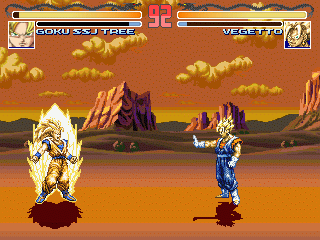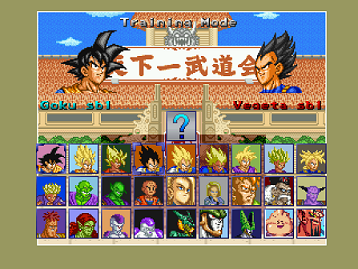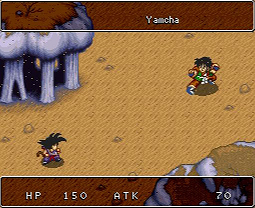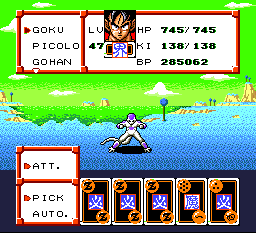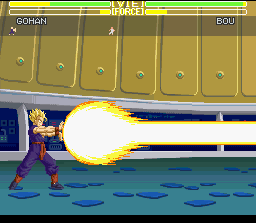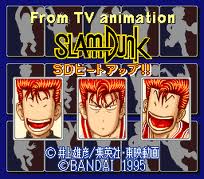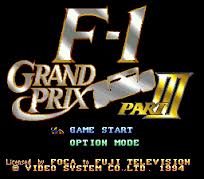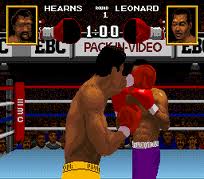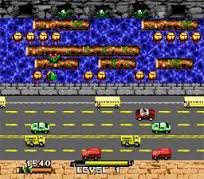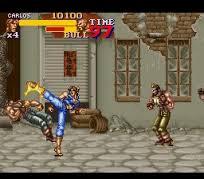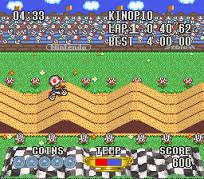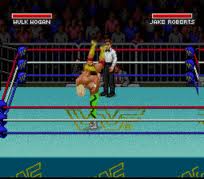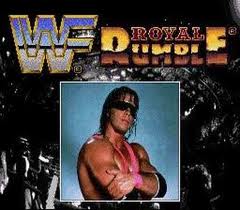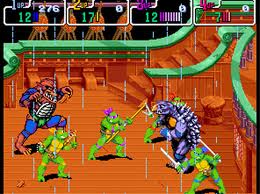Category: 2 Players
47 game(s)A list of 2 player games
Street Fighter II Turbo - Hyper Fighting
Street Fighter II' Turbo: Hyper Fighting (Japanese: ストリートファイターIIダッシュターボ -HYPER FIGHTING) is a competitive fighting game released for the arcades by Capcom in 1992. It is the third game in the Street Fighter II sub-series of Street Fighter games following Street Fighter II': Champion Edition. Released less than a year after the previous installment, Hyper Fighting introduced a faster playing speed and new special moves for certain characters, as well as further refinement to the character balance.
Hyper Fighting is the final arcade game in the Street Fighter II series to use the original CP System hardware. It was distributed as an upgrade kit designed to be installed into Champion Edition printed circuit boards.[1] The next game in the series, Super Street Fighter II, upgraded to the CP System II.
Dragon Ball Z - Hyper Dimension
Dragon Ball Z (Japanese: ドラゴンボールZ(ゼット), Hepburn: Doragon Bōru Zetto, commonly abbreviated as DBZ) is a Japanese anime television series produced by Toei Animation. Dragon Ball Z is the sequel to the Dragon Ball anime and adapts the last 325 chapters of the original 519-chapter Dragon Ball manga series created by Akira Toriyama, that were published from 1988 to 1995 in Weekly Shōnen Jump. Dragon Ball Z first aired in Japan on Fuji TV from April 25, 1989 to January 31, 1996, before being dubbed in several territories around the world, including the United States, Australia, Europe, India, and Latin America.
Dragon Ball Z follows the adventures of the protagonist Goku who, along with his companions, defends the Earth against an assortment of villains ranging from intergalactic space fighters and conquerors, unnaturally powerful androids and near indestructible magical creatures. While the original Dragon Ball anime followed Goku from his childhood into adulthood, Dragon Ball Z is a continuation of his adult life, but at the same time parallels the maturation of his son, Gohan, as well as the evolution of his rivals Piccolo and Vegeta from enemies into allies.
Due to the success of the anime in America, the manga chapters comprising its story were released by Viz Media under the title Dragon Ball Z. Additional works called animanga were released, which adapt the animation to manga form. Dragon Ball Z's popularity has spawned numerous releases which have come to represent the majority of content in the Dragon Ball universe; including 14 movies and 148 video games, many of them being only released in Japan, and a host of soundtracks stemming from this material. Dragon Ball Z remains a cultural icon through numerous adaptations, including a remastered broadcast as Dragon Ball Kai (ドラゴンボール改(カイ), Doragon Bōru Kai, lit. "Dragon Ball Revised") from 2009 to 2011 and from 2014 onwards.
Dragon Ball Z - Super Butouden
Dragon Ball Z (Japanese: ドラゴンボールZ(ゼット), Hepburn: Doragon Bōru Zetto, commonly abbreviated as DBZ) is a Japanese anime television series produced by Toei Animation. Dragon Ball Z is the sequel to the Dragon Ball anime and adapts the last 325 chapters of the original 519-chapter Dragon Ball manga series created by Akira Toriyama, that were published from 1988 to 1995 in Weekly Shōnen Jump. Dragon Ball Z first aired in Japan on Fuji TV from April 25, 1989 to January 31, 1996, before being dubbed in several territories around the world, including the United States, Australia, Europe, India, and Latin America.
Dragon Ball Z follows the adventures of the protagonist Goku who, along with his companions, defends the Earth against an assortment of villains ranging from intergalactic space fighters and conquerors, unnaturally powerful androids and near indestructible magical creatures. While the original Dragon Ball anime followed Goku from his childhood into adulthood, Dragon Ball Z is a continuation of his adult life, but at the same time parallels the maturation of his son, Gohan, as well as the evolution of his rivals Piccolo and Vegeta from enemies into allies.
Due to the success of the anime in America, the manga chapters comprising its story were released by Viz Media under the title Dragon Ball Z. Additional works called animanga were released, which adapt the animation to manga form. Dragon Ball Z's popularity has spawned numerous releases which have come to represent the majority of content in the Dragon Ball universe; including 14 movies and 148 video games, many of them being only released in Japan, and a host of soundtracks stemming from this material. Dragon Ball Z remains a cultural icon through numerous adaptations, including a remastered broadcast as Dragon Ball Kai (ドラゴンボール改(カイ), Doragon Bōru Kai, lit. "Dragon Ball Revised") from 2009 to 2011 and from 2014 onwards.
Dragon Ball Z - Super Gokuuden Totsugeki Hen
Dragon Ball Z (Japanese: ドラゴンボールZ(ゼット), Hepburn: Doragon Bōru Zetto, commonly abbreviated as DBZ) is a Japanese anime television series produced by Toei Animation. Dragon Ball Z is the sequel to the Dragon Ball anime and adapts the last 325 chapters of the original 519-chapter Dragon Ball manga series created by Akira Toriyama, that were published from 1988 to 1995 in Weekly Shōnen Jump. Dragon Ball Z first aired in Japan on Fuji TV from April 25, 1989 to January 31, 1996, before being dubbed in several territories around the world, including the United States, Australia, Europe, India, and Latin America.
Dragon Ball Z follows the adventures of the protagonist Goku who, along with his companions, defends the Earth against an assortment of villains ranging from intergalactic space fighters and conquerors, unnaturally powerful androids and near indestructible magical creatures. While the original Dragon Ball anime followed Goku from his childhood into adulthood, Dragon Ball Z is a continuation of his adult life, but at the same time parallels the maturation of his son, Gohan, as well as the evolution of his rivals Piccolo and Vegeta from enemies into allies.
Due to the success of the anime in America, the manga chapters comprising its story were released by Viz Media under the title Dragon Ball Z. Additional works called animanga were released, which adapt the animation to manga form. Dragon Ball Z's popularity has spawned numerous releases which have come to represent the majority of content in the Dragon Ball universe; including 14 movies and 148 video games, many of them being only released in Japan, and a host of soundtracks stemming from this material. Dragon Ball Z remains a cultural icon through numerous adaptations, including a remastered broadcast as Dragon Ball Kai (ドラゴンボール改(カイ), Doragon Bōru Kai, lit. "Dragon Ball Revised") from 2009 to 2011 and from 2014 onwards.
Dragon Ball Z - Super Saiya Densetsu
Dragon Ball Z - Ultime Menace
Dragon Ball Z (Japanese: ドラゴンボールZ(ゼット), Hepburn: Doragon Bōru Zetto, commonly abbreviated as DBZ) is a Japanese anime television series produced by Toei Animation. Dragon Ball Z is the sequel to the Dragon Ball anime and adapts the last 325 chapters of the original 519-chapter Dragon Ball manga series created by Akira Toriyama, that were published from 1988 to 1995 in Weekly Shōnen Jump. Dragon Ball Z first aired in Japan on Fuji TV from April 25, 1989 to January 31, 1996, before being dubbed in several territories around the world, including the United States, Australia, Europe, India, and Latin America.
Dragon Ball Z follows the adventures of the protagonist Goku who, along with his companions, defends the Earth against an assortment of villains ranging from intergalactic space fighters and conquerors, unnaturally powerful androids and near indestructible magical creatures. While the original Dragon Ball anime followed Goku from his childhood into adulthood, Dragon Ball Z is a continuation of his adult life, but at the same time parallels the maturation of his son, Gohan, as well as the evolution of his rivals Piccolo and Vegeta from enemies into allies.
Due to the success of the anime in America, the manga chapters comprising its story were released by Viz Media under the title Dragon Ball Z. Additional works called animanga were released, which adapt the animation to manga form. Dragon Ball Z's popularity has spawned numerous releases which have come to represent the majority of content in the Dragon Ball universe; including 14 movies and 148 video games, many of them being only released in Japan, and a host of soundtracks stemming from this material. Dragon Ball Z remains a cultural icon through numerous adaptations, including a remastered broadcast as Dragon Ball Kai (ドラゴンボール改(カイ), Doragon Bōru Kai, lit. "Dragon Ball Revised") from 2009 to 2011 and from 2014 onwards.
From TV Animation Slam Dunk - SD Heat Up!!
From TV Animation Slam Dunk – SD Heat Up!!
F-1 Grand Prix Part III
The Ring: Final Knockout
Boxing Legends of the Ring (known in Japan as ファイナルノックアウト (Final Knockout?)) is a boxing video game for the Mega Drive/Genesis and Super NES consoles. The boxers are represented by 2D sprites seen from over the shoulder of one of the fighters. The title of the game refers to the famous boxing magazine, The Ring, which the game is licensed to associate itself with. The following famous middleweight boxers are represented in the game: Sugar Ray Leonard, Roberto Durán, Thomas Hearns, James Toney, Marvin Hagler, Jake LaMotta, Sugar Ray Robinson, and Rocky Graziano.
All of the fights in the game take place in the Las Vegas Hilton casino in the North American version. There are also advertising banners for HBO visible during fights that are not available in the Japanese version. In the Japanese version, the game takes place in a generic boxing ring using the publisher's name in place of the HBO advertisements found in the North American version. Even in the Japanese version, the options are mostly in English.
A special version was released in Mexico and the American Southwest called Chavez II; the game exchanged the English language words for Spanish and omitted some vocals.
Frogger
Final Fight 2
Final Fight 2 is a side-scrolling beat 'em up video game released by Capcom for the Super Nintendo Entertainment System (SNES) in 1993. It is a sequel to the coin-operated arcade game Final Fight, which was previously also released for the SNES. Final Fight 2 was developed by Capcom's consumer division with no preceding coin-op version. The game was re-released onto Wii's Virtual Console service in 2009 for the North American and European regions.
Unlike the SNES version of the first game, Final Fight 2 supports two-player simultaneous play and has a total of three playable characters. The only playable character from the first game to return is Mike Haggar. Two new player characters were introduced: Carlos and Maki Genryusai. In the game's plot, the three battle the resurgent Mad Gear gang at various locations around the world to rescue Maki's sister and father, who are also the fiancée and teacher respectively of Guy from the first Final Fight.
Capcom followed up the game with another SNES-exclusive sequel, Final Fight 3, which saw the return of Guy to the series. None of the new characters from Final Fight 2 returned, although Maki made appearances in various Capcom fighting games years later.
Excitebike Bunbun Mario Battle Stadium
Excitebike: Bun Bun Mario Battle Stadium (エキサイトバイク ぶんぶんマリオバトルスタジアム Ekisaitobaiku Bun Bun Mario Batoru Sutajiamu: noting that "bun bun" is a Japanese onomatopoeia for buzzing sounds - in this case, produced by the motorcycles - this title can also be understood as simply "Excitebike: Mario Battle Stadium") is a remake/adaptation of the NES title, Excitebike. In this game, all human motorcyclists were replaced with Mario characters. As a Satellaview title, Nintendo developed the video game and released four versions of it through the satellite download service operated by St.GIGA, each expanding on or replacing the features of the last.
WWF Super WrestleMania
WWF Super WrestleMania is a multiplatform wrestling video game based on the World Wrestling Federation, released in 1992 for the Super Nintendo Entertainment System and the Sega Mega Drive/Sega Genesis.
Two other 16-bit WWF games, WWF Royal Rumble and WWF Raw, were released which retained the "tug-of-war" style grappling system, where moves are performed by locking up and out-tapping the other player or the computer to execute a move.
WWF Royal Rumble
WWF Royal Rumble is a professional wrestling video game released by LJN in 1993 for the Super NES and Sega Genesis. Like its predecessor, WWF Super WrestleMania it is based on the World Wrestling Federation. It features a variety of match types, including the newly added Royal Rumble match. The game's roster consists of wrestlers who were top stars in the WWF at the time, and each version of the game has five exclusive playable characters.
The game boasts several new features, including an on-screen meter grappling meter and steel chairs that can be used as weapons. Royal Rumble also adds a variety of new moves, including illegal tactics such as choking and each wrestler's signature finishing moves.
The game was followed up with the Sega Mega-CD release WWF Rage in the Cage and a direct sequel, WWF Raw.
Teenage Mutant Ninja Turtles: Tournament Fighters
Teenage Mutant Ninja Turtles: Tournament Fighters, or Teenage Mutant Hero Turtles: Tournament Fighters in Europe, is the title of three different fighting games based on the Teenage Mutant Ninja Turtles franchise, produced by Konami for the Nintendo Entertainment System, Mega Drive/Genesis, and Super NES and released during a period between 1993 and 1994. Konami produced a different fighting game based on the franchise for each platform, featuring a differing cast of characters.

